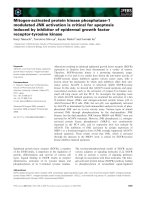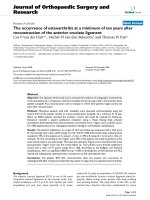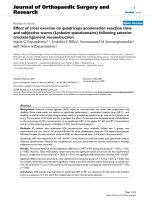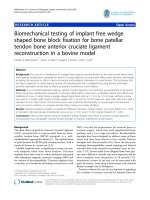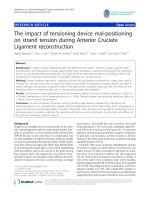Hamstring Tendon Autograft for ACL Reconstruction
Bạn đang xem bản rút gọn của tài liệu. Xem và tải ngay bản đầy đủ của tài liệu tại đây (2.64 MB, 42 trang )
Hamstring Tendon Autograft for
ACL Reconstruction
BS. Nguyễn Trọng Anh
INTRODUCTION
The success of anterior cruciate ligament
(ACL) reconstruction:
Initial tensile properties of the graft
tissue
The initial fixation of the graft,
The healing at the graft fixation sites,
The biologic remodeling of the graft,
Type of postoperative rehabilitation
program used.
patellar tendon autograft: “gold
standard” for ACL
reconstruction.
Fourstranded hamstring tendon
autografts have become an
increasingly popular graft choice
for ACL reconstruction
Strong points:
Biomechanically, as strong as PTB.
Faster recovery of quadriceps muscle
strength.
Lower incidence of donor site pain.
Less interference with kneeling and
crawling.
History and Physical Examination
Initial injury and subsequent injuries and
previous treatment.
Lachman and pivot shift tests
Imaging
XRAY: associated bone
injury, joint space
narrowing, skeletal
maturity.
A true lateral view in
maximum hyperextension
preoperative planning
of the tibial tunnel in the
sagittal plane.
Blumensaate line
MRI
Associated injuries to the PL, PM, other structures.
continued complaints of instability or failure of the ACL
reconstruction.
Indications and Contraindications
Acute or chronic ACL reconstruction.
Pt whose occupation, lifestyle, or religion requires “knee
walking,” crawling, or kneeling.
Pt with patellofemoral pain or patellar tendinopathy.
Pt with open growth plates.
Absolute contraindication: previous harvest of the hamstring
tendons.
Caution: Significant loss of knee flexor strength at high flexion
angles at athletes require maximum flexor strength at high angles
of flexion. gymnasts, wrestlers, sprinters, and American football…
Femoral Fixation Options
Loop suspension + cross pins
provide strong femoral
fixation with minimal
slippage during cyclic
loading:
Fixation strength is high.
Slippage during cyclic
loading is minimal.
The fit of the tendon in
the bone tunnel is tight.
The 360 degrees of contact
between the bone tunnel wall
and the hamstring tendon graft
enhances healing.
The amount of graft inserted
into the femoral tunnel can be
customized.
Removal of the implant is not
required in revision cases.
Fixation properties are not
dependent on the bone quality
of the distal femur.
Tibial Fixation Options
Weak link of ACL graft fixation.
Tibial fixation of hamstring tendon grafts
remains: lower bone mineral density of the
proximal tibia, fixation devices must resist
shear forces applied parallel to the axis of
the tibial bone tunnel.
Surgical Technique
General or regional anesthesia.
A padded pneumatic tourniquet
Supine positon
The leg holder, dropping feet
1. Hamstring tendon graft harvest
2. Graft preparation
3. Arthroscopic portal placement
4. Preparation of the intercondylar notch
5. Femoral tunnel
6. Tibial tunnel
7. Calculation of femoral fiaxation syst. Length
and graft preparation
8. Graft passage and femoral fixation
9. Graft tensioning
10. Tibial fixation
11. Closure
Hamstring Tendon Graft Harvest
Hamstring Tendon Graft Harvest
Graft Options: Hamstring
harvest
1
3
2
4
Graft Preparation
Place sutures in ends
Double the semit and gracilis over a #5 Ticron
Whip stitch the proximal end with #0 Vicryl
Suture the distal end with Krakow, #2 Ticron
Measure the size of the 4 bundles
Endobutton
Portal Placement
AnteroLateral
Anteromedial
Anteromedial
Oblique,
middle of
soft spot
Low
Low
anteromedial
anteromedial
above
abovemedial
medial
meniscus,
next
meniscus,
next
totopatellar
patellar
tendon
tendon
Diagnostic Arthroscopy
ACL Stump Debridement
Debridement of the
ACL stump
to avoid anterior
impingement
remove fat in notch
to visualize posterior
fringe
Notchplasty
Notchplasty
only sufficient bone
to accommodate the
graft
visualize the
posterior fringe
Tibial Tunnel
Tibial Guide: Set 45
500
External Landmarks
5 cm below joint line
2 cm from mid line(10
150 in sagital plane)
Internal Landmarks
5 mm from PCL
Midline
Posterior to the
lateral meniscus edge
Drill same size as 4
bundle graft
